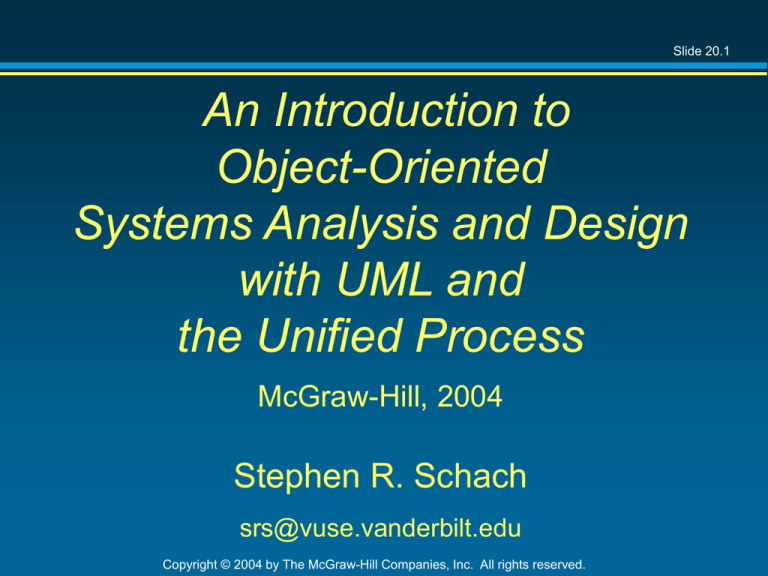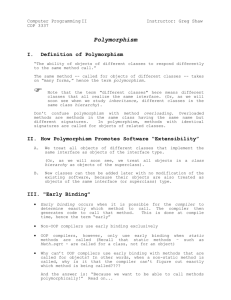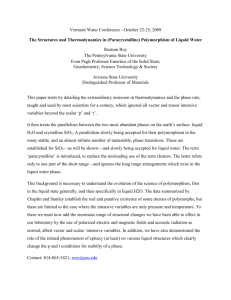
Slide 20.1
An Introduction to
Object-Oriented
Systems Analysis and Design
with UML and
the Unified Process
McGraw-Hill, 2004
Stephen R. Schach
srs@vuse.vanderbilt.edu
Copyright © 2004 by The McGraw-Hill Companies, Inc. All rights reserved.
CHAPTER 20
TECHNICAL TOPICS
Copyright © 2004 by The McGraw-Hill Companies, Inc. All rights reserved.
Slide 20.2
Chapter Overview
Slide 20.3
Source Code and Compiled Code
Modularity
Polymorphism and Dynamic Binding
Example of Polymorphism and Dynamic Binding
Maintenance Implications of Polymorphism and
Dynamic Binding
Copyright © 2004 by The McGraw-Hill Companies, Inc. All rights reserved.
Source Code and Compiled Code
Programmers do not write all the code themselves
– They invoke run-time routines as needed
Slide 20.4
A program exists in three forms
– Source code
– Compiled code
– Executable load image
Copyright © 2004 by The McGraw-Hill Companies, Inc. All rights reserved.
Source Code and Compiled Code (contd)
Slide 20.5
Source code
– Written in a language such as COBOL, C, C++, or Java
Source code has to undergo two transformations
– It is compiled into compiled code (“object code”)
– The compiled code is combined (linked) with the run-time
routines it needs to form an executable load image
Copyright © 2004 by The McGraw-Hill Companies, Inc. All rights reserved.
Source Code and Compiled Code (contd)
Slide 20.6
Transformation of source code into an executable
load image
Copyright © 2004 by The McGraw-Hill Companies, Inc. All rights reserved.
Source Code and Compiled Code (contd)
Slide 20.7
Monolithic information systems are inefficient
– Changing a single line requires complete recompilation
Instead, a large information system should consist of
a number of smaller code artifacts (or modules)
– Now, only one model needs to be recompiled, followed by
– The relinking of all the compiled code modules into an
executable load image
Copyright © 2004 by The McGraw-Hill Companies, Inc. All rights reserved.
Source Code and Compiled Code (contd)
Slide 20.8
Recompiling one module, then relinking
Copyright © 2004 by The McGraw-Hill Companies, Inc. All rights reserved.
Modularity
Slide 20.9
A large information system must be decomposed
into modules
– How is this decomposition to be performed?
Ensure that functionality coincides with module
boundaries, that is,
– All modules must have high cohesion
– The methods (implementations of the operations) must be
strongly related to one another, and weakly related to the
methods of the other modules
Copyright © 2004 by The McGraw-Hill Companies, Inc. All rights reserved.
Modularity (contd)
Slide 20.10
The traditional paradigm is:
– Determine the client’s needs (requirements phase)
– Draw up the specifications (analysis phase)
– Design the information system as a set of modules with
high cohesion (design phase)
– Code the modules (implementation phase)
Cohesion is a fundamental principle of traditional
design
Copyright © 2004 by The McGraw-Hill Companies, Inc. All rights reserved.
Modularity (contd)
Slide 20.11
The design criterion of maximizing the cohesion of a
module
– Relates to solely to operations, and
– Ignores data
This is the weakness of the traditional paradigm
What is needed is a paradigm that gives equal
weight to data and operations
– The object-oriented paradigm
Copyright © 2004 by The McGraw-Hill Companies, Inc. All rights reserved.
Modularity (contd)
Cohesion was first put forward in 1976
Best: Functional cohesion
Slide 20.12
– A module has functional cohesion when it performs only
one operation
Second best: Informational cohesion
– A module has informational cohesion when it performs a
number of related operations, all on the same data
Copyright © 2004 by The McGraw-Hill Companies, Inc. All rights reserved.
Modularity (contd)
Slide 20.13
A class is a module with informational cohesion
Copyright © 2004 by The McGraw-Hill Companies, Inc. All rights reserved.
Modularity (contd)
Slide 20.14
There are two possible ways multiple objects
(instances of classes) could be implemented:
– (a) Multiple instances of the attributes, multiple instances
of the code for the methods
– (b) Multiple instances of the attributes, a single instance of
the code for each method
Approach (b) is automatically achieved by using an
object-oriented programming language
Copyright © 2004 by The McGraw-Hill Companies, Inc. All rights reserved.
Modularity (contd)
Slide 20.15
(a) Incorrect and (b) correct implementation of objects
Copyright © 2004 by The McGraw-Hill Companies, Inc. All rights reserved.
Polymorphism and Dynamic Binding
The term polymorphism comes from two Greek
words meaning “many shapes”
Example: Bank Card Class
Copyright © 2004 by The McGraw-Hill Companies, Inc. All rights reserved.
Slide 20.16
Polymorphism and Dynamic Binding (contd)
Slide 20.17
In a traditional information system, there have to be
two different functions (methods),
– print_monthly_statement_for_credit_card, and
– print_monthly_statement_for_debit_card
Copyright © 2004 by The McGraw-Hill Companies, Inc. All rights reserved.
Polymorphism and Dynamic Binding (contd)
Slide 20.18
At run-time, each card is examined in turn
– If it is a credit card, the monthly statement is printed by
» Function print_monthly_statement_for_credit_card
– If it is a debit card, the monthly statement is printed by
» Function print_monthly_statement_for_debit_card
Copyright © 2004 by The McGraw-Hill Companies, Inc. All rights reserved.
Polymorphism and Dynamic Binding (contd)
Slide 20.19
In an object-oriented information system, choice of
method is handled automatically
Copyright © 2004 by The McGraw-Hill Companies, Inc. All rights reserved.
Polymorphism and Dynamic Binding (contd)
Slide 20.20
In superclass Bank Card Class
– declare an abstract (or virtual) method printMonthlyStatement
In each of the subclasses
– Implement a method for printing that type of monthly
statement, also called printMonthlyStatement
When the monthly statements are being printed, the
system
– Automatically detects the card type, and
– Invokes the appropriate version of printMonthlyStatement
Copyright © 2004 by The McGraw-Hill Companies, Inc. All rights reserved.
Polymorphism and Dynamic Binding (contd)
Slide 20.21
There are two different implementations of method
printMonthlyStatement
– Polymorphism
The relevant version of printMonthlyStatement is “bound”
to the credit or debit card while the information
system is running
– Dynamic binding
Copyright © 2004 by The McGraw-Hill Companies, Inc. All rights reserved.
Polymorphism and Dynamic Binding (contd)
Slide 20.22
Polymorphism and dynamic binding make
development easier
There is no need to write code to
– Test whether an object is (say) a credit card or a debit
card, and then
– Invoke the appropriate function
Instead, the decision is made automatically by the
object-oriented run-time system
Copyright © 2004 by The McGraw-Hill Companies, Inc. All rights reserved.
Example of Polymorphism and Dynamic Binding
Slide 20.23
While performing the design workflow, allocation of
methods to classes is based on three factors
– Responsibility-driven design
– Inheritance
– Polymorphism and dynamic binding
Copyright © 2004 by The McGraw-Hill Companies, Inc. All rights reserved.
Example of Polymorphism and Dynamic Binding
Slide 20.24
Example: MSG Foundation case study
– Interaction diagrams include the messages:
» Print list of mortgages, and
» Print list of investments
Method printAsset must be able to print either an
investment or a mortgage
Copyright © 2004 by The McGraw-Hill Companies, Inc. All rights reserved.
Example of Polymorphism and Dynamic Binding
Slide 20.25
Traditional paradigm
– Two different functions are needed, namely
» Function print_investment, and
» Function print_mortgage
The information system must
– First determine the type of the asset, then
– Invoke the appropriate function
Copyright © 2004 by The McGraw-Hill Companies, Inc. All rights reserved.
Example of Polymorphism and Dynamic Binding
Slide 20.26
Object-oriented paradigm
– Method printAsset utilizes polymorphism and dynamic
binding
Copyright © 2004 by The McGraw-Hill Companies, Inc. All rights reserved.
Example of Polymorphism and Dynamic Binding
Slide 20.27
Version 1: Wrong allocation of method printAsset
Copyright © 2004 by The McGraw-Hill Companies, Inc. All rights reserved.
Polymorphism and Dynamic Binding Example
Slide 20.28
Version 1 uses inheritance instead of polymorphism
– Method printAsset in class Asset Class is inherited
unchanged by the two subclasses
Copyright © 2004 by The McGraw-Hill Companies, Inc. All rights reserved.
Example of Polymorphism and Dynamic Binding
Slide 20.29
Version 2: Correct allocation of method printAsset
Copyright © 2004 by The McGraw-Hill Companies, Inc. All rights reserved.
Example of Polymorphism and Dynamic Binding
Slide 20.30
Version 2 uses polymorphism and dynamic binding
– Method printAsset in class Asset Class is abstract (or
virtual)
– There are two actual implementations of printAsset
» One in class Investment Class, and
» One in class Mortgage Class
Copyright © 2004 by The McGraw-Hill Companies, Inc. All rights reserved.
Example of Polymorphism and Dynamic Binding
Slide 20.31
When method printAsset is invoked
– The object-oriented run-time system determines the class
of the object that is invoking method printAsset
– The object can be an instance of
» Class Investment Class, or
» Class Mortgage Class
– The run-time system must go to the appropriate class, and
– Execute the implementation of method printAsset found there
Copyright © 2004 by The McGraw-Hill Companies, Inc. All rights reserved.
Maintenance Implications of Polymorphism
Slide 20.32
Consider Version 2 again:
Copyright © 2004 by The McGraw-Hill Companies, Inc. All rights reserved.
Maintenance Implications of Polymorphism
Slide 20.33
Suppose the information system fails
– The run-time system prints a message stating that the
cause of the failure is “method printAsset”
The maintainer cannot tell which was responsible:
– The version of method printAsset in subclass Investment
Class, or
– The version of method printAsset in subclass Mortgage
Class
Copyright © 2004 by The McGraw-Hill Companies, Inc. All rights reserved.
Maintenance Implications of Polymorphism
Slide 20.34
The strength of polymorphism and dynamic binding
– The object-oriented run-time system automatically handles
which version of printAsset is to be invoked
– The potential ambiguity is automatically resolved
However, when something goes wrong at run-time
– There is no way to tell which of the two identically named
methods is the cause of the problem
– The ambiguity cannot be resolved
Copyright © 2004 by The McGraw-Hill Companies, Inc. All rights reserved.
Maintenance Implications of Polymorphism
Slide 20.35
Polymorphism and dynamic binding are extremely
powerful aspects of object-oriented technology that
– Promote development, but
– Can have a deleterious impact on maintenance
Copyright © 2004 by The McGraw-Hill Companies, Inc. All rights reserved.







